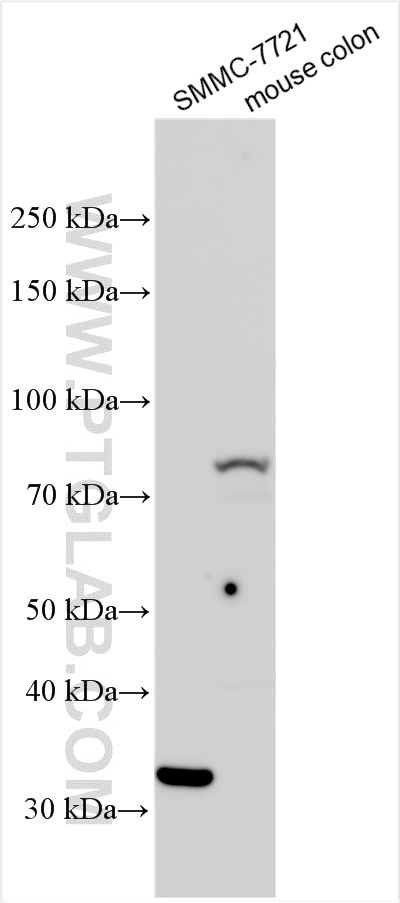Anticorps Polyclonal de lapin anti-TGM3
TGM3 Polyclonal Antibody for WB, ELISA
Hôte / Isotype
Lapin / IgG
Réactivité testée
Humain
Applications
WB, ELISA
Conjugaison
Non conjugué
N° de cat : 21406-1-AP
Synonymes
Galerie de données de validation
Applications testées
| Résultats positifs en WB | cellules SMMC-7721, |
Dilution recommandée
| Application | Dilution |
|---|---|
| Western Blot (WB) | WB : 1:2000-1:10000 |
| It is recommended that this reagent should be titrated in each testing system to obtain optimal results. | |
| Sample-dependent, check data in validation data gallery | |
Informations sur le produit
21406-1-AP cible TGM3 dans les applications de WB, ELISA et montre une réactivité avec des échantillons Humain
| Réactivité | Humain |
| Hôte / Isotype | Lapin / IgG |
| Clonalité | Polyclonal |
| Type | Anticorps |
| Immunogène | TGM3 Protéine recombinante Ag16131 |
| Nom complet | transglutaminase 3 (E polypeptide, protein-glutamine-gamma-glutamyltransferase) |
| Masse moléculaire calculée | 693 aa, 77 kDa |
| Poids moléculaire observé | 77 kDa; 30-35 kDa; 44-50 kDa |
| Numéro d’acquisition GenBank | BC109076 |
| Symbole du gène | TGM3 |
| Identification du gène (NCBI) | 7053 |
| Conjugaison | Non conjugué |
| Forme | Liquide |
| Méthode de purification | Purification par affinité contre l'antigène |
| Tampon de stockage | PBS with 0.02% sodium azide and 50% glycerol |
| Conditions de stockage | Stocker à -20°C. Stable pendant un an après l'expédition. L'aliquotage n'est pas nécessaire pour le stockage à -20oC Les 20ul contiennent 0,1% de BSA. |
Informations générales
TGM3 (Transglutaminase 3) is a Protein Coding gene. Diseases associated with TGM3 include Uncombable Hair Syndrome 2 and Uncombable Hair Syndrome 1. Transglutaminases are enzymes that catalyze the crosslinking of proteins by epsilon-gamma glutamyl lysine isopeptide bonds. While the primary structure of transglutaminases is not conserved, they all have the same amino acid sequence at their active sites and their activity is calcium-dependent. The protein encoded by this gene consists of two polypeptide chains activated from a single precursor protein by proteolysis. The encoded protein is involved the later stages of cell envelope formation in the epidermis and hair follicle. TG3 is expressed as an inactive 77 kDa zymogen which must be activated by limited proteolytic processing into two fragments (44 kDa and 30 kDa) of which the larger, N-terminal fragment carries the catalytic activity (PMID: 35328331).
Protocole
| Product Specific Protocols | |
|---|---|
| WB protocol for TGM3 antibody 21406-1-AP | Download protocol |
| Standard Protocols | |
|---|---|
| Click here to view our Standard Protocols |


